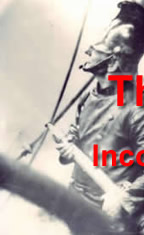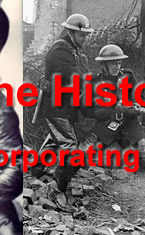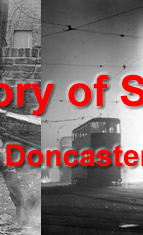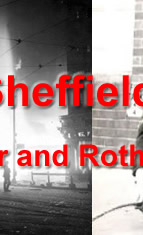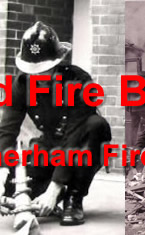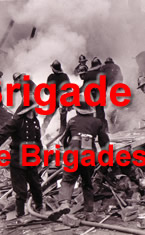
At the age 57 Charles Teather was reassigned as a Senior Division Officer in No. 3 Fire Force Area. The restructuring of the service came about because of criticisms leveled at the government for providing insufficient leadership during 1940 and early 1941. In fact, the only action taken by the Home Office was to send inspectors to provincial cities to report on bomb-damage, and to distribute a series of memoranda to local authorities encouraging careful preparations to combat incendiary fires. The absence of a direct chain of command between the Home Office and the 1,450 brigades further undermined resource co-ordination. Pressure from several senior officers in the London Region about the inadequate level of protection in provincial cities culminated in the appointment of the Labour MP Herbert Morrison as Home Secretary in October 1940.
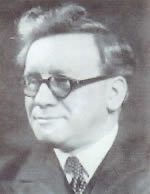 |
Formerly leader of the London County Council, Morrison was sympathetic to the demands for greater government control of the service. Negotiations, however, lagged, and it took the heavy raids of April 1941 to force Morrison to propose nationalisation to the War Cabinet, which duly ratified the scheme on 8 May. During parliament's debate of the Fire Service(Emergency Provisions) Bill, Morrison insisted that there was a clear difference between peacetime and wartime fire protection, stating that 'fire-fighting, in substance, had become a military operation, and, certainly for the period of the war, had ceased to be a municipal one.' | 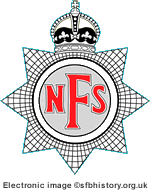 |
It took just thirteen weeks to nationalise the fire service. Even the Treasury, notoriously resistant to allowing exchequer support for fire protection, agreed to fund all emergency costs as well as a quarter of each brigade's peacetime costs. Yet, like so much public policy towards fire protection before, during and after the war, nationalization was a knee-jerk reaction to fire disasters.
| Furthermore, although it was national in name, in practice the National Fire Service (NFS) was a regional structure. Britain was divided into 39 Fire Forces, each commanded by a Fire Force Commander; each Fire Force was divided into separate divisions and further sub-divided into 'Columns' and, finally, 'Companies'. The Fire Force Commanders were responsible to Chief Regional Fire Officers, who exercised extensive powers over the deployment of manpower and equipment within their boundaries. There were between 2 and 4 Fire Forces in each region. The best officers were stationed in those areas deemed of the highest importance, which meant many existing officers were relocated, demoted or pensioned off. Furthermore, the AFS was incorporated into the NFS, which went some way to ending the animosity between the auxiliary and professional fire-fighters, and abolished the police brigades. The only brigades which remained outside the NFS were the hundreds of works brigades that protected industrial premises and were funded by their parent companies (many of which had rendered valuable assistance during the air-raids of 1940-41, especially in the West Midlands). | 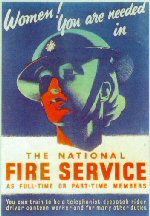 |
National Fire Service Personnel on parade at Division Street Fire Station
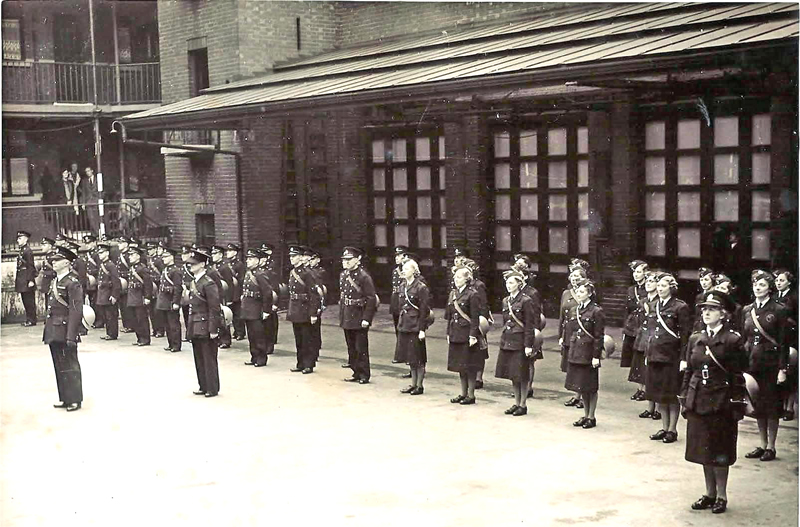 |
| Photograph courtesy of Mrs Elizabeth Beardsley (6th from the right) age 97 (in 2015) |
 In fact the relative rapidity of nationalisation, when it came, was only possible because of the series of preceding piecemeal reforms of 1937-40.
In fact the relative rapidity of nationalisation, when it came, was only possible because of the series of preceding piecemeal reforms of 1937-40.
The establishment of the Fire Service Inspectorate in 1937, and the formation of the Regional Commissioners in 1938 helped to lay the groundwork for nationalization by centralizing responsibility for fire policy, dividing the country into manageable regions, and inspecting local standards.
Moreover, the Home Office had been involved in the procurement of appliances, especially pumping and ancillary equipment, and the improvement of water supplies as well as the standardisation of hydrants, since 1938, and had ordered local authorities to draw up risk-assessment plans (as they are now known) in order to allocate resources. Evidently, the Home Office had also learned from the delays in establishing mutual assistance schemes during the First World War by creating 12 special area schemes in 1939 under emergency powers.
The creation of a separate Fire Brigade ('K') Department within the Home Office (previously the fire service had been the administrative responsibility of the Police Department) and the hiring of a Fire Adviser to the Home Secretary were the final 'preparatory' steps.
Owing to the threat to national security, Morrison only gave 'K' Department three months to make the transition from local to national footing, during which time the constitution and organization of the NFS was formalized. By the autumn of 1941 the NFS was fully operational, with 'K' Department issuing instructions and conducting inspections on a frequent basis to co-ordinate service delivery.
This transition, however, was undertaken during a period of virtual inactivity by the Luftwaffe. Indeed, the NFS never faced air-raids to the extent of those experienced in 1940-41, although the Tip-and-Run and Baedecker raids and the 'Little Blitz' all challenged the new structure. In fact the performance of the structure was far from a glowing success, largely owing to its multiplicity of tiers.
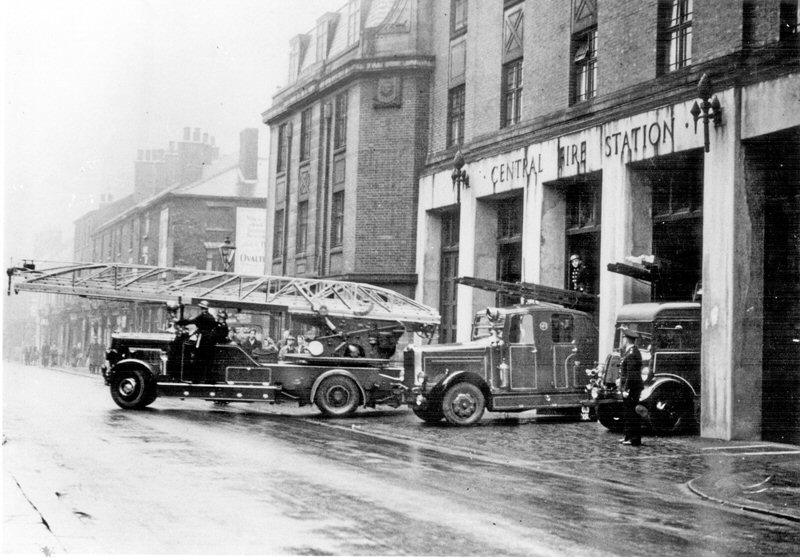
NFS Turnout from Division Street Fire Station
Disputes between the 'K' Department, Regional Commissioners and some Fire Force Commanders over the powers of setting conditions of service, the mobilization of appliances and other operational procedures such as procurement led to friction at the higher levels.
Members of the National Fire Service and the former Sheffield Fire Brigade at Westbourne Road, Sheffield:
 |
| Members of the former Sheffield City Fire Brigade and members of the National Fire Service, Westbourne Road, Sheffield, (Later the base for Radio Sheffield). Photograph courtesy of Christine Dowding, daughter of Harold Mason who is standing far right. Any further information will be appreciated. |
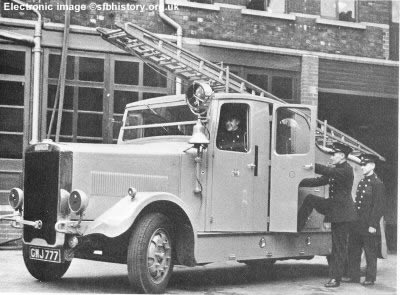 Headlamps shielded because of air raid precautions, this new 45hp fire pump, with 2,000 feet of hose and a 40 gallon tank, started work in Sheffield in 1941. |
At the operational level, Column and Company Officers argued over who was responsible for directing fire fighters during incidents, while Divisional Officers clashed with Fire Force Commanders and their assistants when implementing policy. Absolute responsibility for the operation and the administration of the Fire Service passed to the Home Office and financial responsibility was assumed by the Government as from the 1st July, 1941, subject to a standard contribution by Local Authorities equal to 75 per cent of the rate levied for peace-time Fire Brigade purposes for the year 1939-1940. Administrative control passed to the Home Office on the 18th August, 1941 and on this date the City of Sheffield Police Fire Brigade ceased to exist and became part of No. 3 Area of the National Fire Service. |
Sheffield, along with a small part of the West Riding of Yorkshire formed the "A" and "B" Divisions of this area. Superintendent C. Teather became the Senior Divisional Officer and was attached initially to "B" Division with Headquarters at "Bishopholme", Herries Road, Chief Inspector J. W. Singleton was appointed Divisional Officer of "A" Division. The active strength of personnel within the Area covered by the former Sheffield Brigade and Auxiliary Fire Service at this time was over 1.000 whole-time men and some 250 women with nearly 700 part-time personnel of both sexes. Nearly 300 pumping appliances were available. The organisation was built up in anticipation of air raids which fortunately did not materialise and the peak strength was nearly 1,300 whole-time personnel and 2,000 part-time. |
        Malin Bridge AFS, 1941 |
The advent of the NFS changed the existing Sheffield Police Fire Brigade rank structures as follows:
| Police Ranks | National Fire Service Ranks | ||
| Men | Women | Helmet Markings | |
| Constable | Fireman | Firewoman | Khaki Steel Helmet |
| Leading Fireman | Leading Firewoman | Khaki Steel Helmet - 1 Narrow Red band | |
| Sergeant | Section Leader | Senior Leading Firewoman | Khaki Steel Helmet - 2 Narrow Red bands |
| Inspector | Company Officer | Assistant Group Officer | Khaki Steel Helmet - 1 Broad Red band |
| Chief Inspector | Senior Company Officer | Group Officer | Khaki Steel Helmet - 1 Narrow Red band over 1 Broad Red band |
| Superintendent | Column Officer | Assistant Area Officer | White Steel Helmet - 1 Narrow Red band |
| Chief Superintendent | Divisional Officer | Area Officer | White Steel Helmet - 2 Narrow Red bands |
| Assistant Fire Force Commander | Regional Woman Fire Officer | White Helmet - Broad Red band | |
| Fire Force Commander | White Steel Helmet - Broad Red circular band and broad red bar inscribed Fire Force Commander | ||
| Chief Regional Fire Officer | White Steel Helmet - Broad Red circular band and broad red bar inscribed Chief Regional Fire Officer | ||
| Senior Staff Officer | |||
| Inspector | |||
| Chief of the Fire Staff & Inspector-in-Chief | |||
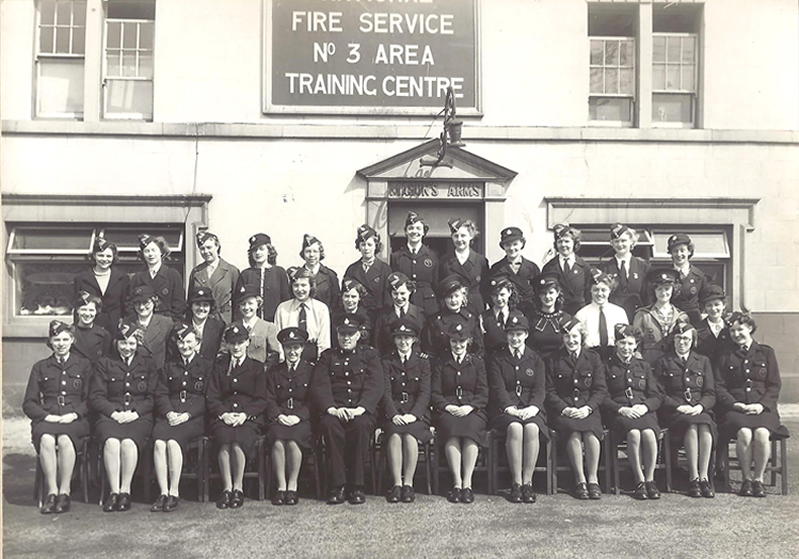 |
| National Fire Service, No. 3 Area Training Centre, Masons Arms, Wickersley Photograph courtesy of Mrs Elizabeth Beardsley (second from the left on the front row) To view the signatures of the back of the card >click here< |
View a list of the Sheffield NFS Firefighters who lost their lives during WWII (Opens on a new page)
Editors Note: The resident training centre for women was established at the Old Mason's Arms, Wickersley early in 1942, about 30 women attending each course of approximately 24 days. The various courses held included some for recruits, telephonists. cooks, drivers and administrative staff.
The former bar parlour was fitted out as a model control room, and was put to extensive use in the training of telephonists and control room staff, whilst the concert room was used as the main Lecture room.
Sleeping accommodation was provided for the students at Sycamore House, at the corner of Bawtry Road and Morthen Road.
Not only did the National Fire Service spawn a new rank structure it also brought about a steady influx of new utilitarian fire appliances derived from mass produced military vehicles. These vehicles quickly replaced the local authority and the acquisitioned motor cars and trailers which had been used throughout the heaviest bombing raids of the war. However, this new breed of fire appliances brought about the innovation of the covered crew cab, and for the first time protection from the elements was included in fire appliance design. The new fire appliance colour for the NFS was battleship grey.
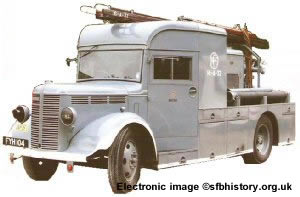 |
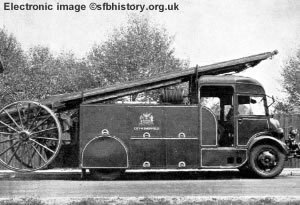 Photograph shows the NFS appliance retained at Elm Lane Fire Station after the war. |
Bedford Heavy Unit:During World War 2 around 1,000 pumps were built on the Bedford chassis,and most were capable of producing 700gpm through four delivery outlets. A second variant was also built which could deliver 1,100gpm through six deliveries. These were designated as Extra Heavy Units. |
1943 Austin K4 Escape Carrying Unit: Built to Home Office specifications for the National Fire Service, the appliance was fitted with a Barton front mounted pump. |
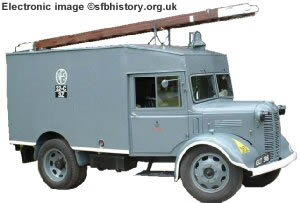 |
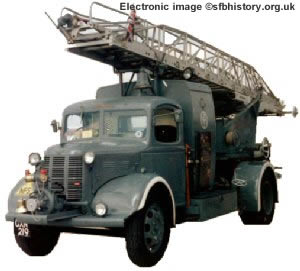 |
Austin K2 Auxiliary Towing Vehicle: Based on the 2 ton lorry chassis,they were fitted with utility bodywork accommodating a crew of six,hoses and a 30ft ladder. Some 4,000 of these vehicles were ordered by the Home Office during the Second World War for the N.F.S. They were mainly used to tow heavy trailer pumps, and to carry equipment and crew. The Austin K2 units were not designed to carry water. |
Austin K4/Merryweather 60ft hand-operated Turntable Ladder: with front mounted American Barton pump. A total of fifty hand-operated Merryweather turntables were built and mounted on Austin K4 chassis for the Home Office between 1942/43. These appliances were designed to be used by crews who were not necessarily qualified turntable ladder operators. |
          |
| Photograph of the Sheffield NFS crews who were sent to Beverley as reinforcements. Sheffield crews were also sent to reinforce hard pressed Area Commands in Birmingham, Coventry, Liverpool, Hull, Manchester and Leeds. Photograph SFB Archives |
Death of Sheffield Fire Force Chief
 |
On 29th October 1942, following a major operation on October 6th, Mr. Charles Teather, Senior Divisional Officer of the N.F.S. in No. 3 Fire Force Area, in charge of the two Sheffield divisions. died in the Sheffield Royal Infirmary. He was 57. By virtue of his position and his robust manner, Mr. Teather was one of the best known men in Sheffield. He was known too, in fire service quarters further afield. He followed the true tradition of the firemen being courageous, resourceful and thorough, and was an inspiring leader of the men he commanded. Rapid Promotion |
Valediction
In 1937 following the departure of Superintendent T. Breaks to take up a Home Office appointment, Mr. Teather was made acting superintendent.
He would probably have retired about that time owing to his age but the unsettled state of Europe and the possibility of war influenced the authorities in retaining his services. He was appointed superintendent in 1938.
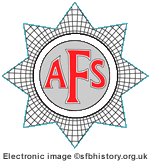 |
Trained Auxiliary Service He exerted his abundant energies to the task of recruiting and training the Auxiliary Fire Service, and by the time the war broke out, Sheffield had a strong body of part-time firemen. In the subsequent air raids they ably supplemented the work of the regular firemen. When the fire brigades of the country were reorganised and the N.F.S. created. Mr. Teather was made Senior Divisional Officer. |
For his gallant conduct at a fire at Darnall in 1932 when four children lost their lives, he was awarded the silver medal of the Society for the Protection of Life from Fire. In 1936 he received the medal of the National Canine Society for rescuing a dog from a fire.
Senior Divisional Officer Teather was a widower with two children, a son in the R.A.F. and a daughter whose husband is a fireman in Sheffield.
          Picture SFB Archives The Funeral cortege of Superintendent C. Teather leaves Division Street Fire Station |
Mi Amigo - B17 Flying Fortress Crash - Encliffe Park
Whilst many aircraft crashed on the moors around Sheffield, one crash in particular, is remembered due to its closeness to everyone. This short section relates to the crash of the American Airforce B-17 (Mi Amigo) in Endcliffe Park, and is dedicated to my late Great Uncle Robert Plane, one of the first NFS Firemen to reach the scene.
As dusk fell on 22 February 1944, a B-17 Flying Fortress (Mi Amigo) of the 8th Air Force fell from the sky over Sheffield, and crashed in woodland at the edge of Endcliffe Park. In spite of the efforts of townsfolk, none of its crew of ten could be saved.
A memorial stone which, weighs half a ton is located in Endcliffe Park, it carries not one but two bronze plaques, stands about fifty metres from the café and is surrounded by ten oak trees deliberately planted to commemorate the lost airmen. In spite of this, it is deceptively easy to overlook. >>More detail about the Mi Amigo crash
‘COURAGE ABOVE THE CLOUDS: THE TRUE STORY OF THE HEROIC CREW OF B17 ‘MI-AMIGO’.’
Published in 2014 this is a true story of young men, in aerial combat, displaying extraordinary courage and fortitude. The crash of B17 ‘Mi-Amigo’ in Endcliffe Park, Sheffield, on February 22nd 1944, returning badly damaged from a mission over Occupied Europe, with the crew sacrificing themselves to save lives on the ground, is truly heroic. Using newly-released material from military archives, the story of that fateful day is told fully for the first time by Paul Allonby.
With Paul's permission you are invited to view the book.
1941- 1944 Air Raids:
During 1941 the period 1942 the Luftwaffe mounted further 'Tip-and-Run' and Baedecker raids against Sheffield.
|
Date |
Area mainly affected |
Deaths |
| 1941 | 12th October | Ellesmere Road, Pitsmoor | 9 |
| 20th October | Clarkehouse Road and Endcliffe Terrace Road | 2 | |
| 1942 | 1st September | Psalter Lane | 1 |
| 1944 | 25th April | Prince of Wales Road and Hastilar Road | 2 |
During this period the following NFS Firemen died:
| Harold Parkinson | Fireman, 42 years of age. Injured at fire on 29th December 1942: Died on 11th August 1943 at Sheffield from smoke inhalation. |
| Leonard Harrison | Died in a minefield, 13th April 1944 while on transfer to Cullercoats near Newcastle. On 13th April 1944, he and his crew were called to a moorland fire where one of them trod on a mine which killed the entire crew. The moorland had been used as an ammunition dump and unknown to them had been mined. He left a wife and two daughters, age six years and age six months. |
| Harold Gannon | Fireman, 42 years of age. Died on 25th April 1944, in appliance crash Hastilar Road/Prince of Wales Road, whilst proceeding to a fire. |
| Joseph Pardon | Fireman, 40 years of age. Injured on 25th April 1944, in appliance crash Hastilar Road/Prince of Wales Road, whilst proceeding to a fire. Died on 26th April 1944 at Royal Hospital. |
| Malcolm Rawnsley | Fireman, 41 years of age. Injured November 28th, 1944, at Rockingham Street. Died on 2nd January 1945 |
In anticipation of "D" Day on June 6th 1944, numbers of firemen were transferred to coastal areas—particularly the south coast— and immediately afterwards, when it became obvious that the danger of air raids on inland towns had largely passed re-organisation commenced. The Divisions were eliminated and No. 3 Area formed into four Sub-Areas, Sheffield and district becoming Sub Area A.
The first Bomb fell in Sheffield on the night of August 18th, 1940, and the last fell on April 25th, 1944. During this period the Imperial War Graves Commission recorded the deaths of 618 people during the bombings of Sheffield with the majority (466) being killed on the nights of 12-13th and 15th December 1940. All the names of the people who died are recorded on the Sheffield Civilian and Civilian Services Deaths 1939-1945 (Opens on a New Page)
The alert sounded 130 times during the war. Most of the alerts were false alarms due to enemy aircraft flying across the region while on their way to other targets. However, on 16 occasions of those 130 alerts the alarms were genuine.
Victory in Europe Day (V-E Day or VE Day) was May 7 and May 8, 1945, the dates when the World War II Allies formally accepted the unconditional surrender of the armed forces of Germany and the end of the Third Reich. The surrender of Germany was authorised by Hitler's replacement, President of Germany Karl Dönitz. The act of military surrender was signed on May 7 in Reims, France, and May 8 in Berlin, Germany.
Victory over Japan Day (V-J Day, also known as Victory in the Pacific Day, or V-P Day) is a name chosen for the day on which the Surrender of Japan occurred, and subsequent anniversaries of that event. The term has been applied to both the day on which the initial announcement of Japan's surrender was made in the afternoon of August 15, 1945 (August 14 North American date), as well as the date the formal surrender ceremony was performed in Tokyo on September 2, 1945.
The end of the war in 1945 brought about a reduction in the number of personnel and appliances in the Service, nationally and locally, and the necessary re-organisation to cater for peacetime needs was carried out. It was realised, however, that the fire defence of the country would have to be on a much larger scale than pre-war. It is true to say that the war years brought about immense changes in the fire brigade profession, and almost every activity in the service acquired a new outlook.
The inefficiency of centuries was erased during the war years, and it was clear there could not be any return to pre-war conditions if the public and the nation was to have adequate protection from fire.
In 1945 those members of the National Fire Service who had been called up under the provisions of the National Service Acts, were discharged from the service of the Crown and as far as possible many other members were released. Applications were invited for the Post War Fire Service and in 1946 serving members who possessed the necessary qualifications were able to apply for permanent appointment. Many others were recruited from the armed forces.
          Picture SFB Archives Members of N.F.S. No. 3 Area 'A' Division, 22nd March 1945 |
The Return of the Fire Service to Local Control
Herbert Morrison had always stated that nationalisation would be a temporary measure and that fire protection would be returned to local control after the war. This was because local government still retained power and influence over national policy. From 1943 discussions began concerning the post-war status of the service. There were suggestions that the service should remain a national responsibility, especially as the Labour Party promised to nationalise health and public utilities, although this was resisted by Morrison and his successor, Chuter Ede, because of the animosity it would generate within local government. It was eventually decided that the service would be returned to local control, yet with some important reforms.
Final details of the new Local Government Services were contained in this comprehensive Act of Parliament known (Fire Services Act. 1947). The Act governed the return of Fire Brigades to local control and reduced the number of brigades from 1,400 to 134.
A most important requirement of the Act concerns the amount of protection to be provided within the community, and consequently, a minimum establishment of men and appliances are authorised for each Brigade.
The Fire Service Act, 1947, required fire authorities for the first time to provide arrangements for the inspection of property in their area with regard to their risk: to take steps to mitigate damage caused by water and carrying out salvage work: and for giving, when requested, of advice on fire prevention and means of escape in case of fire. It also gave powers for them to delegate their functions in whole or in part to other Fire Authorities.
As from the appointed date, and for the first time in history, the Government were authorised to make a contribution, not exceeding 25% to the cost of administering the Fire Brigades, provided the efficiency of the Brigade is up to the standards required by the Home Office. To ensure that this standard is maintained the Home Office appointed a Chief Inspector of Fire Brigades and a staff of several Inspectors who are known as Her Majesty's Inspectors of Fire Brigades.
The same liability is placed on fire brigades by the 1947 Act as the 1938 Act, (which was repealed in its entirety), i.e., the question of mutual assistance between themselves so that the resources of one are available in case of need to others.
The Secretary of State for the Home Department is the responsible Minister of the Government empowered to administer the Fire Brigades Act and he is authorised to initiate legislation on various cognate matters. Regulations are issued from time to time, dealing with conditions of service, pay, leave, pensions, training, and promotions, thus ensuring that all brigades are administered at the same standard. In making these regulations the Secretary of State must, and does, consult such bodies as Central Fire Brigades Advisory Council and the National Joint Council for Fire Brigades. These bodies are formed of representatives of the Local Authorities, Fire Engineering Technical Bodies and Associations, The Chief Fire Officers' Association, The National Association of Fire Officers and the Fire Brigades Union, thus it is ensured that any regulation made has always been agreed to before its promulgation.
During the latter part of 1947 it was realised that in order to effect a smooth change over to local authority control, certain measures would have to be taken before the Act came into force, consequently each designated Fire Authority had to take such steps as appointing staff.
Extract - Sheffield City Council, Watch Committee, 20th November 1947
Personnel: 173 inclusive of a CFO, a DCFO and 5 Administration Staff |
National Fire Service Resources 1948
Central Fire Station
Appliance |
Type |
Reg |
Year of Purchase |
Fordson 7V Barton ft mtd p |
Pump Escape |
GWJ 777 |
09/41 |
Leyland F5T1 limousine |
Pump |
|
|
Leyland TLM2A Merryweather |
Turntable Ladder |
GWJ 649 |
12/40 |
Dennis Ace limousine |
Rescue Tender |
AWB 835 |
34 |
Austin K2 |
Emergency Tender |
|
|
Trailer Pump |
|
|
|
Darnall Road Fire Station
Appliance |
Type |
Reg |
Year of Purchase |
Leyland FKT1 limousine |
Pump |
FWJ 78 |
02/39 |
|
Pump |
|
|
Norton Fire Station
Appliance |
Type |
Reg |
Year of Purchase |
|
Pump |
|
|
|
Water Tender |
|
|
Woodhouse Road Fire Station
Appliance |
Type |
Reg |
Year of Purchase |
|
Pump Escape |
|
|
|
Pump |
|
|
Elm Lane Fire Station
Appliance |
Type |
Reg |
Year of Purchase |
|
Pump Escape |
|
|
|
Pump |
|
|
Dennis Lancet Merryweather |
Turntable Ladder Pump |
GGK 941 |
(42) 47 |
In 1948 the National Fire Service was disbanded and control of Fire Brigades was passed back to the Local Authorities. However, the responsibility for Sheffield Fire Brigade now passed from the Police Authority to the newly formed Fire Authority. However, what was certain is there was a lot of work to do.
          Photograph showing the view from the rear of the Sheffield Star Offices across to Angel Street in 1948. Courtesy of the Sheffield Star - Sheffield at War 1939-1945 |
